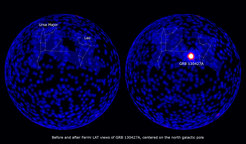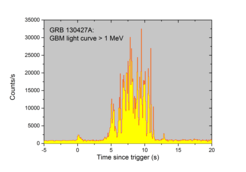Fermi/GBM Detects Brightest Gamma-Ray Burst in Decades
"On Saturday morning during breakfast, I was alerted by an automated message that the Fermi satellite had triggered on a GRB,” says Dr. Andreas von Kienlin, the burst advocate on duty on this historic day. "When the data were downlinked from the satellite and I saw them for the first time I couldn't believe my own eyes. This GRB was so incredibly bright that it saturated our detectors. The GRB community hasn't seen such a bright event in the last 30 years and it was the brightest that GBM ever detected". Thrilled by this detection, Andreas von Kienlin immediately submitted a notification to the scientific community encouraging further ground-based observations. "We can be exceptionally proud of the detection of this event as all 14 gamma-ray detectors and the power-supply of the GBM instrument were developed, built and tested here at MPE." says Andreas von Kienlin.

The GBM is a collaborative effort between the National Space Science and Technology Center in the U.S. and the MPE. Thanks to the very wide energy range covered by both the GBM and the LAT Fermi has measured the prompt emission spectrum of GRB130427A over an unprecedentedly large energy range (from ~8 keV to ~100 GeV).
Fermi's Large Area Telescope (LAT) recorded one gamma ray with an energy of at least 94 billion electron volts (GeV), or some 35 billion times the energy of visible light, and about three times greater than the LAT's previous record. The GeV emission from the burst lasted for hours, and it remained detectable by the LAT for the better part of a day, setting another new record for the longest gamma-ray emission from a GRB.

The burst subsequently was detected in optical, infrared and radio wavelengths by ground-based observatories, based on the rapid accurate position information from NASA’s Swift satellite which also triggered on the event. Astronomers quickly learned that the GRB was located about 3.8 billion light-years away, which for these events is relatively close. “That this explosion, billions of light years away, was saturating our detectors shows how incredible violent the event was,” said Andreas von Kienlin.
Gamma-ray bursts are the universe's most luminous explosions. Astronomers think that the majority occur when massive stars run out of nuclear fuel and collapse under their own weight. As the stellar core collapses into a black hole, jets of material shoot outward at nearly the speed of light. These jets bore all the way through the collapsing star and continue into space, where they interact with gas previously expelled by the star and generate bright afterglows that fade with time. If the GRB is near enough, astronomers usually discover a supernova a week or so after the outburst happened. This GRB belongs to the closest 5 percent of bursts, so ground-based observatories are monitoring its location in hopes of finding an underlying supernova.
News Update:Five papers published online on 21 November 2013
The Gamma-Ray Burst GRB 130427A is the subject of five papers published online on 21. November 2013. These highlight additional observations of the burst obtained by the trio of NASA satellites, Fermi, Swift and NuSTAR, working in concert with the ground-based robotic telescopes RAPTOR (see links), which captured never-before-seen details of the event that challenge current theoretical understanding of how gamma-ray bursts work.
The spectacular results from the Gamma-Ray Burst Monitor show that our widely accepted picture of MeV gamma rays from internal shock waves is woefully inadequate.
The optical flash observed by the Rapid Telescope for Optical Response (RAPTOR) peaked when Fermi's Large Area Telescope (LAT) detected a spike in GeV gamma rays reaching 95 GeV. This marks the first detailed look at the relationship between a burst’s optical light and its high-energy gamma rays. It was the common understanding that visible light for these flashes came from internal shocks, but this burst conclusively shows that it must come from the external shock, which produces the most energetic gamma-rays.
More puzzling is a single 32 GeV gamma ray, which was detected by Fermi LAT 9 hours after the burst's onset. A late arrival with this kind of energy raises questions about how well scientists really understand the physics of the external shock wave.
For a gamma-ray burst, GRB 130427A was relatively nearby. Its light traveled 3.8 billion years before arriving at Earth, about one-third of the travel time for light from typical bursts. Detailed observations by Swift and ground-based telescopes clearly show that GRB 130427A has properties more similar to typical distant bursts rather than to nearby ones.
The burst's extraordinary brightness enabled the Nuclear Spectroscopic Telescope Array (NuSTAR) to make the first detection of a burst afterglow in high-energy, or "hard," X-rays after more than a day. Taken together with Fermi LAT data, these observations challenge long-standing predictions.













